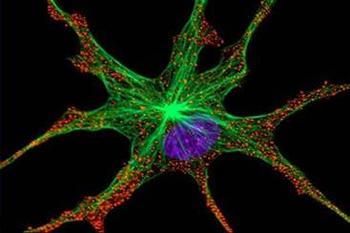New fluorescence imaging technology can clearly show vascular pulsation
 According to a recent report by the Physicist Organization Network, scientists at Stanford University in the United States have developed a fluorescence imaging technology that enables the pulsation of living animals to be presented with unprecedented clarity. Compared with the traditional imaging technology, its increased clarity is similar to the fog before wiping off the glasses. The study was published in the latest issue of the online edition of the journal Nature Medicine.
According to a recent report by the Physicist Organization Network, scientists at Stanford University in the United States have developed a fluorescence imaging technology that enables the pulsation of living animals to be presented with unprecedented clarity. Compared with the traditional imaging technology, its increased clarity is similar to the fog before wiping off the glasses. The study was published in the latest issue of the online edition of the journal Nature Medicine. This technique is called near infrared-II imaging, or NIR-II. The researchers first inject water-soluble carbon nanotubes into the living body's blood, and then use a laser to illuminate the object to be observed, such as a mouse. The wavelength of the laser in the near-infrared range, about 0.8 microns, can result in specially designed carbon nanotubes emitting longer wavelengths of fluorescence from 1 micron to 1.4 microns, which are used to determine the structure of blood vessels.
Carbon nanotubes emit longer fluorescence wavelengths than traditional imaging techniques, which is the key to achieving stunning, clear images of tiny blood vessels. Due to less light scattering at longer wavelengths, a clearer blood vessel image is formed. In addition, this technique allows the image to be presented in more refined detail, allowing researchers to obtain a fast image acquisition rate that measures blood flow in near real time.
Obtaining blood flow information and seeing clear blood vessels at the same time will be particularly useful for studying animal models of arterial disease, such as how blood flow is affected by arterial obstruction and contraction-induced effects, as well as other issues such as stroke and heart attack.
The researchers said: "For medical research, this is a very good tool for observing the characteristics of small animals. It will help us better understand some of the vascular diseases, and its response to treatment and how we can design more Good treatment."
Since NIR-II can only penetrate the body by 1 cm at most, it will not replace other imaging techniques, but will supplement X-ray, CT, MRI, and laser Doppler techniques. However, it is a powerful method for studying animal models.
The researchers said that the next step will be to make this technology more accessible to humans and to explore alternative fluorescent molecules. They hope to find substances that are smaller than carbon nanotubes and can emit light of the same wavelength so that they can be easily discharged from the body, eliminating any toxic concerns.
Auto Double Iridium Spark Plug
Our company was set up in 2002.We are using the advanced cold punch technology to produce spark plug which is similar to NGK and Champion technology.With such technology, the metal shell and ceramic are better protected the quality of the spark plug are more stable to get avoid from air leaking and broken.Our spark plug products are ranged into more than 100 models with an anual out put of 6 million pcs. Besides the advanced technology,we also have a strong advantage of automatical production.Most of our production device is automatical that we have very high,efficiency and stable quality.Throughout such years of developing,we have gained a good reputation at domestic motorcycle manufacturer.Furthermore,our products have been exported to South East Asia, Middle East, Australia and so on. Revolution,refine and devotion are our principal of working.Welcome to visit us and raise your demand and your comments request are our target to strive.
Denso Spark Plug,Auto Iridium Spark Plug,Spark Plugs For A Car,Iridium Spark Plug For Car
LIXIN INDUSTRIAL & TRADE CO.,Limited , https://www.jmsparkplug.com